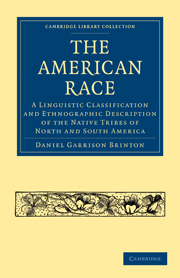 The American Race
The American Race II - THE NORTH PACIFIC GROUP
Published online by Cambridge University Press: 29 August 2010
Summary
THE NORTHWEST COAST AND CALIFORNIAN TRIBES
THE lofty chains of the Rocky Mountains extend from north to south, leaving a narrow coast line seamed with deep and fertile valleys along the Pacific from Mt. St. Elias to the Gulf of California. In spite of its great extent in latitude—from the 30th to the 60th degree—there is less difference in climate than one would suppose from analogy in any other part of the world. The warm ocean current which bathes the northern coast mitigates the cold of the winter to such an extent that the isothermal lines on the Pacific are fifteen degrees of latitude more northerly than on the Atlantic border of the continent.
A few of the eastern stocks, the Athabascan and the Shoshonian, have sent out colonies who have settled on the banks of the Pacific; but as a rule the tribes of the western coast are not connected with any east of the mountains. What is more singular, although they differ surprisingly among themselves in language, they have marked anthropologic similarities, physical and psychical. Virchow* has emphasized the fact that the skulls from the northern point of Vancouver's Island reveal an unmistakable analogy to those from the southern coast of California; and this is to a degree true of many intermediate points. Not that the crania have the same indices. On the contrary, they present great and constant difference within the same tribe; but these differences are analogous one to the other, and on fixed lines.
- Type
- Chapter
- Information
- The American RaceA Linguistic Classification and Ethnographic Description of the Native Tribes of North and South America, pp. 103 - 117Publisher: Cambridge University PressPrint publication year: 2009First published in: 1891
